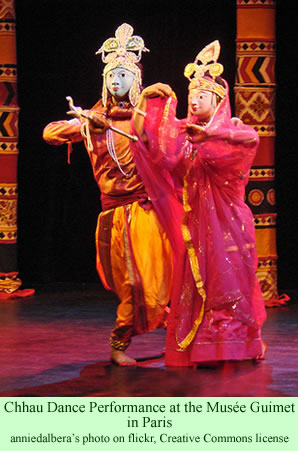Sitaram Shikari, an 18-year old from a village in West Bengal State of India, may be the first young Birhor person to be accepted into college as an undergraduate student. Raised in the village of Bhupatinagar, in Bagmundi town, the Purulia District of West Bengal, the young man has completed his schooling and has found a mentor in the college who has secured funding so he can continue with his higher education.
 Bagmundi is well known in eastern India as a center for what are called Chhau dances. Performing dancers wear masks that signify characters in the major Indian epics, so they can only express their thoughts and emotions through their movements. The elaborate masks are made by artisans in a village in Bagmundi. The rich artistic tradition contrasts with the nearby Birhor settlement.
Bagmundi is well known in eastern India as a center for what are called Chhau dances. Performing dancers wear masks that signify characters in the major Indian epics, so they can only express their thoughts and emotions through their movements. The elaborate masks are made by artisans in a village in Bagmundi. The rich artistic tradition contrasts with the nearby Birhor settlement.
Sitaram comes from the much poorer village, a place with 25 Birhor families, 278 people. There are many Naxalite guerillas in the area. This Birhor band used to hunt monkeys, snakes, and wild boars for food in Jharkhand State, plus make ropes out of forest vines for sale. Since their forests were mostly destroyed, however, they were no longer able to subsist there. They migrated to the Purulia District where they are able to sell some forest products, primarily wood, in town.
Sitaram has been admitted to Ramananda Centenary College, a small institution in the town of Purulia. The college is affiliated with the University of Burdwan, also located in West Bengal. Prof. Chandidas Mukhopadhyay, a scholar at the college who has written books on India’s primitive tribal groups, or PTGs, is mentoring the young man. The professor told the press that he has arranged for all of Sitaram’s expenses to be covered, including his room and board in a college hostel.
Sitaram told the press that he grew up “seeing our family members hunt animals in the forest, roast them and eat them.” But, he adds, he has a dream of getting an education, which he wants to use to further help the children of his village to also become educated. He said that no government agency and no NGO has ever taken an interest in his village.
Prof. Mukhopadhyay confirmed that the village had received no attention from government agencies, since the Birhor would not be likely to vote. He added that the “Birhor is the most marginal and endangered tribe of all the PTGs.” He said that development projects had been announced for their community but the funds had never reached the people.